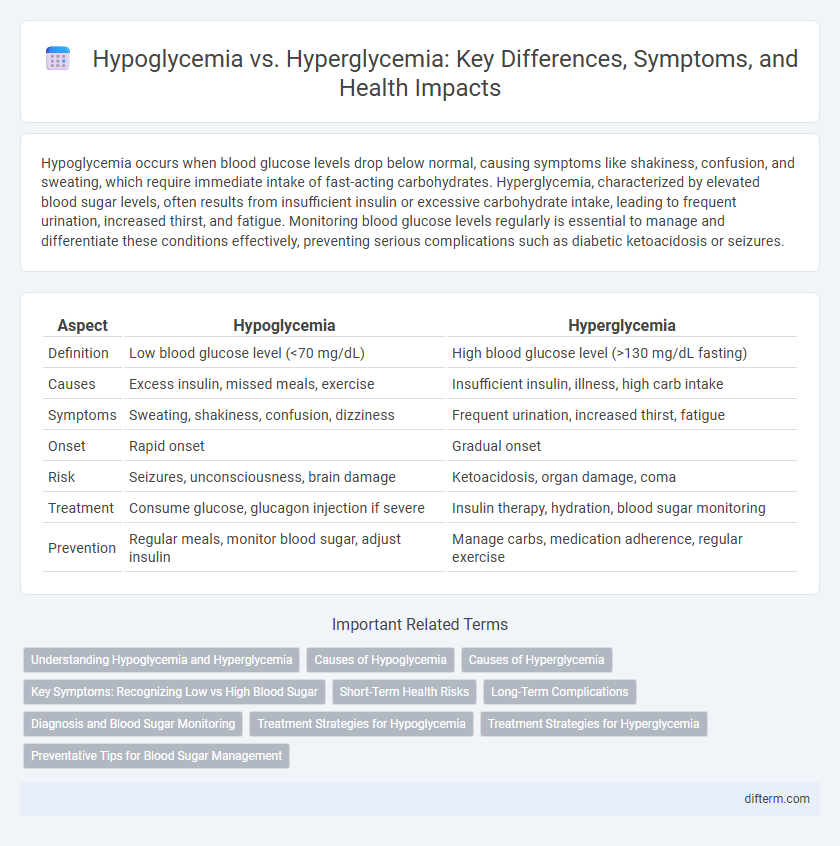Hypoglycemia occurs when blood glucose levels drop below normal, causing symptoms like shakiness, confusion, and sweating, which require immediate intake of fast-acting carbohydrates. Hyperglycemia, characterized by elevated blood sugar levels, often results from insufficient insulin or excessive carbohydrate intake, leading to frequent urination, increased thirst, and fatigue. Monitoring blood glucose levels regularly is essential to manage and differentiate these conditions effectively, preventing serious complications such as diabetic ketoacidosis or seizures.
Table of Comparison
| Aspect | Hypoglycemia | Hyperglycemia |
|---|---|---|
| Definition | Low blood glucose level (<70 mg/dL) | High blood glucose level (>130 mg/dL fasting) |
| Causes | Excess insulin, missed meals, exercise | Insufficient insulin, illness, high carb intake |
| Symptoms | Sweating, shakiness, confusion, dizziness | Frequent urination, increased thirst, fatigue |
| Onset | Rapid onset | Gradual onset |
| Risk | Seizures, unconsciousness, brain damage | Ketoacidosis, organ damage, coma |
| Treatment | Consume glucose, glucagon injection if severe | Insulin therapy, hydration, blood sugar monitoring |
| Prevention | Regular meals, monitor blood sugar, adjust insulin | Manage carbs, medication adherence, regular exercise |
Understanding Hypoglycemia and Hyperglycemia
Hypoglycemia occurs when blood glucose levels fall below 70 mg/dL, leading to symptoms like shakiness, confusion, and sweating, and requires immediate intake of fast-acting carbohydrates. Hyperglycemia is characterized by elevated blood sugar levels above 180 mg/dL, often causing frequent urination, increased thirst, and potential long-term complications such as neuropathy and cardiovascular disease. Proper monitoring and management through diet, medication, and lifestyle adjustments are essential to prevent these dangerous fluctuations and maintain glucose homeostasis.
Causes of Hypoglycemia
Hypoglycemia primarily results from excessive insulin administration, prolonged fasting, or intense physical activity that depletes blood glucose levels. Other causes include certain medications, alcohol consumption, and underlying medical conditions such as insulinomas or adrenal insufficiency. Identifying these triggers is essential for preventing dangerous drops in blood sugar and managing overall metabolic health.
Causes of Hyperglycemia
Hyperglycemia occurs when blood glucose levels rise above the normal range, primarily due to insufficient insulin production or insulin resistance commonly seen in diabetes mellitus. Other causes include excessive carbohydrate intake, physical inactivity, infection, stress, or certain medications such as corticosteroids. Understanding these factors is crucial for managing and preventing complications related to prolonged high blood sugar.
Key Symptoms: Recognizing Low vs High Blood Sugar
Hypoglycemia symptoms include shakiness, sweating, confusion, and rapid heartbeat, signaling dangerously low blood sugar levels. Hyperglycemia presents with increased thirst, frequent urination, fatigue, and blurred vision, indicating elevated glucose in the bloodstream. Timely recognition of these distinct signs is vital for effective blood sugar management and preventing complications in diabetes care.
Short-Term Health Risks
Hypoglycemia causes immediate symptoms such as dizziness, confusion, sweating, and in severe cases, seizures or loss of consciousness due to dangerously low blood sugar levels. Hyperglycemia leads to short-term complications including increased thirst, frequent urination, fatigue, and blurred vision, which can rapidly worsen if untreated. Both conditions require prompt management to prevent acute medical emergencies like diabetic ketoacidosis in hyperglycemia or hypoglycemic coma.
Long-Term Complications
Chronic hypoglycemia can lead to neurological damage, cognitive impairment, and increased risk of seizures due to insufficient glucose supply to brain cells. Long-term complications of hyperglycemia include diabetic retinopathy, nephropathy, neuropathy, and cardiovascular diseases caused by prolonged elevated blood glucose levels. Effective management of blood sugar levels is critical to prevent these severe and potentially irreversible health outcomes.
Diagnosis and Blood Sugar Monitoring
Accurate diagnosis of hypoglycemia and hyperglycemia relies on blood glucose measurements using glucometers or continuous glucose monitoring (CGM) systems, with hypoglycemia defined by blood sugar levels below 70 mg/dL and hyperglycemia typically above 180 mg/dL after meals. Frequent blood sugar monitoring is essential for managing both conditions, allowing for timely adjustments in insulin, diet, or medication to maintain optimal glucose levels. Hemoglobin A1c tests complement daily monitoring by reflecting average blood sugar control over the past two to three months, aiding in long-term management decisions.
Treatment Strategies for Hypoglycemia
Treatment strategies for hypoglycemia primarily involve the rapid administration of fast-acting carbohydrates such as glucose tablets, fruit juice, or sugary snacks to quickly raise blood glucose levels. In severe cases, glucagon injections or intravenous dextrose may be necessary to prevent neurological damage and restore normal glycemia. Consistent monitoring and individualized adjustments in medication, diet, and physical activity are crucial to effectively manage hypoglycemic episodes and prevent recurrence.
Treatment Strategies for Hyperglycemia
Treatment strategies for hyperglycemia primarily involve lifestyle modifications, such as adopting a balanced diet rich in fiber and low in simple carbohydrates, regular physical activity, and consistent blood glucose monitoring. Medications, including insulin therapy and oral antidiabetic agents like metformin or sulfonylureas, are critical for managing elevated blood sugar levels in diabetic patients. Timely intervention and individualized treatment plans help prevent complications associated with chronic hyperglycemia, such as neuropathy, retinopathy, and cardiovascular disease.
Preventative Tips for Blood Sugar Management
Maintaining stable blood sugar levels requires balanced nutrition emphasizing low-glycemic index foods, regular physical activity, and consistent meal timing to prevent hypoglycemia and hyperglycemia. Monitoring blood glucose frequently and adjusting insulin or medication doses under medical guidance helps mitigate risks associated with diabetes. Staying hydrated and managing stress through relaxation techniques further supports effective blood sugar control.
hypoglycemia vs hyperglycemia Infographic

 difterm.com
difterm.com